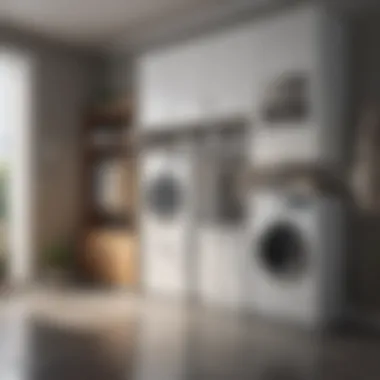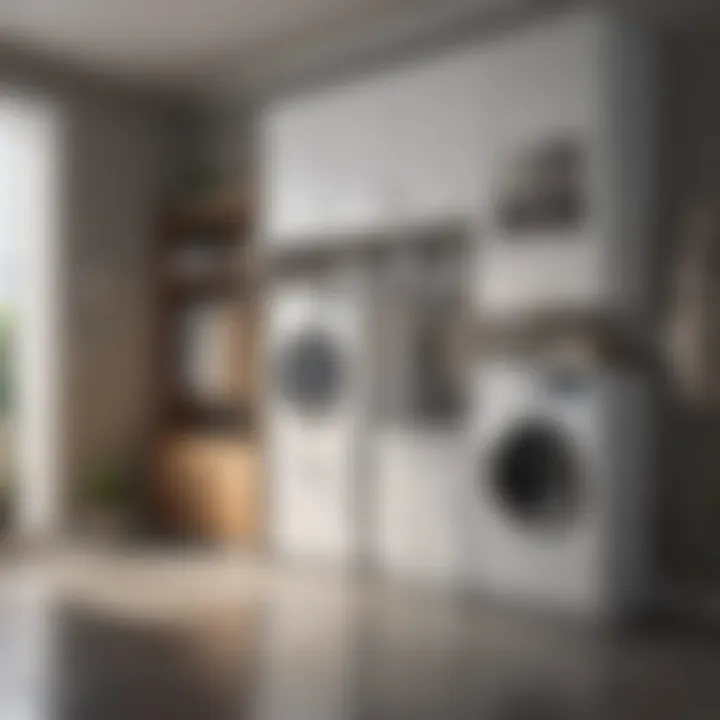Modern Laundry Room Ideas for Stylish Living


Intro
In the sphere of home design, the laundry room has often been overlooked. However, as modern living spaces evolve, so too does the need for this often-utilitarian area to be both functional and visually appealing. Many homeowners now prioritize laundry rooms as essential parts of their living environments. This article explores updated ideas for modern laundry rooms that blend functionality, style, and sustainability.
Design Inspirations
Trending Styles
Contemporary laundry rooms embrace various aesthetics, yet a few styles have surged in popularity. One prominent trend is the minimalist approach. This design emphasizes clean lines, uncluttered spaces, and a limited color palette. Minimalism allows for a calming atmosphere while maintaining essential functionality.
Another inspiring style is the industrial look. Here, raw materials, such as exposed brick and metal fixtures, create an edgy and distinctive vibe. It’s perfect for those who appreciate textures and bold statements within their home.
Additionally, farmhouse chic remains popular. This style brings warmth and comfort, often utilizing distressed wood, vintage decor, and soft linens. Together with modern appliances, it makes even mundane chores feel more pleasant.
Color Palettes
Color selection is crucial in transforming a laundry room. Light and airy tones, such as soft whites, pastel blues, and light greys, contribute to a spacious feeling. These colors reflect light, making the room feel brighter and more inviting.
Conversely, bold colors create a striking visual impact. Deep greens or navy blues have gained traction, providing a backdrop for more eclectic decor elements. A two-toned approach can designate functional areas, like washing and folding zones, enhancing visual separation within the space. Incorporating accents, such as brass or matte black fixtures, adds an elegant touch amidst these colors.
"Color plays a significant role in setting the mood of a space and can change how we feel while doing even the most mundane tasks, such as laundry."
Storage Solutions
A well-organized laundry room requires smart storage solutions. Open shelving is growing in popularity, offering accessibility alongside decorative potential. Attractive baskets or labeled bins can help maintain order while adding character.
Closets are another option. Built-in cabinetry maximizes vertical space, accommodating both appliances and ample storage. For compact spaces, utilizing underutilized areas, such as behind the door or above the appliances for hanging items, can greatly improve efficiency.
Sustainability Features
Sustainability is vital in modern laundry rooms. Energy-efficient appliances, such as those produced by brands like LG or Samsung, consume less water and electricity. Also, biodegradable detergents are a healthier choice for both the home and the environment.
Moreover, integrating features like a water recycling system can minimize wastage. Choosing eco-friendly materials for cabinetry or flooring adds to the overall effectiveness of a green laundry room.
Culmination
Updating a laundry room to reflect modern style is an endeavor worth pursuing. It not only enhances daily chores but also increases the overall value of a home. By incorporating innovative designs, thoughtful color choices, effective storage solutions, and sustainable practices, homeowners can transform a typically dreary area into a stylish, efficient, and enjoyable environment.
Intro to Laundry Room Transformations
A laundry room may seem like a mundane space in the home, yet it holds significant potential for transformation. With effective design and thoughtful planning, a laundry space can evolve from a mere functional area into a stylish and organized environment. The article focuses on several aspects of the modern laundry room, emphasizing how contemporary design can enhance utility without sacrificing aesthetics.
Importance of a Functional Laundry Room
A functional laundry room is more than an area to wash clothes; it reflects the household's efficient lifestyle. It serves as a hub for chores, and an organized space enables quicker completion of tasks. A well-designed laundry room can streamline the workflow by ensuring that all necessary items are within reach. For instance, incorporating proper storage solutions can minimize clutter and maximize usability.
Moreover, an efficient laundry room can reduce time spent on laundry duties. When space is designed with functionality in mind, everyday tasks can become less daunting. Making laundry a more pleasant experience promotes a healthier home environment. Thus, a functional laundry room is essential not only for the household's operational efficiency but also for enhancing overall well-being.
Elements of Modern Design
Modern design elements revolve around simplicity and practicality, combining technology with style. Key components include:
- Clean Lines: Straight edges and minimal ornamentation characterize modern design, creating a sleek look.
- Neutral Color Palettes: Soft, neutral colors can soothe the senses and create a calming effect, perfect for a space often associated with stress.
- Natural Light: Maximizing daylight enhances mood and reduces the need for artificial lighting during the day. Windows or skylights can significantly impact the environment.
- Smart Technology: Incorporating smart appliances reflects the current trend of seamless integration of technology into daily life. These devices offer convenience and efficiency, such as machines that can be controlled remotely.
Ultimately, incorporating these elements into laundry room design encourages a synergy between function and beauty, creating a space that is not only practical but also visually appealing.
"A modern laundry room becomes part of the home’s aesthetic rather than a neglected corner of the house."
Space Planning and Layout
Space planning and layout are pivotal in the transformation of laundry rooms. The effectiveness of this often-overlooked area heavily relies on how space is utilized. A well-planned layout can drastically improve both efficiency and the overall experience of doing laundry. This consideration encompasses the placement of appliances, walking areas, and storage options, ensuring every square inch serves a purpose.
Optimizing Small Spaces
In smaller homes, laundry rooms can feel cramped. However, strategic design choices can maximize functionality. Consider using wall-mounted shelves to create vertical storage, allowing for a more open floor space. Compact appliances, such as the Bosch Series 4 washing machines, will also be beneficial. Place these in a corner to free up the front of the room. Utilize mobile carts or pull-out bins that can collapse or slide away when not in use. This method keeps the room organized without sacrificing style.
Open-Concept Laundry Areas


The trend of open-concept living has extended to laundry spaces as well. Integrating the laundry room into a larger living area promotes a sense of connectivity. This design choice enhances flow while allowing for a cohesive aesthetic. For instance, using a folding partition can subtly divide the rooms when needed, yet maintain an airy feel. If you adopt this style, match colors and materials with adjacent areas, ensuring the laundry room does not feel like an afterthought. The aim should be to create a seamless blend of functionality and allure, potentially incorporating decorative elements like art or plants.
Zone Layout for Efficiency
Implementing a zone layout is essential for creating a laundry room that promotes efficiency and ease of use. By designating areas for specific tasks—such as washing, drying, and folding—you can minimize movement and streamline your process. For example, the washing machine should be close to the dryer to avoid extra trips across the room, while a designated folding area nearby can facilitate a smooth workflow. This approach allows for more accessibility of supplies and tools, such as detergents or fabric softeners, strategically positioned within arm's reach. It increases time efficiency, enhancing the overall experience of managing laundry tasks.
Color Schemes and Materials
In the design of modern laundry rooms, color schemes and materials play a significant role in bridging functionality with style. The choices made here can profoundly impact not only the room's overall aesthetic but also its perceived space and atmosphere. A well-thought-out color palette can enhance the mood of the room, while the right materials ensure durability and practicality. It is essential for homeowners to consider how these elements align with their personal tastes and the overall design of the home.
Neutral Palettes for a Calming Effect
Neutral colors are often favored in laundry rooms because they evoke a sense of tranquility. Shades like whites, beiges, and soft grays can visually expand small spaces, making them feel larger and more inviting. These colors tend to act as a backdrop for other design elements, allowing furniture and decor to shine without overwhelming the senses. Additionally, a neutral palette can create a clean, uncluttered look, which is desirable in a space primarily dedicated to chores.
- Benefits of Using Neutral Palettes:
- Promotes a calming atmosphere.
- Versatile; pairs well with a range of accent colors.
- Helps to hide dirt and stains, which is practical for laundry.
In practical terms, opting for a neutral color scheme can also ease future design choices. Homeowners may find it easier to switch out accessories or decor without needing to repaint the walls.
Bold Accents to Enhance Aesthetics
While neutrals serve as the base, bold colors can inject life into a laundry room. Using contrasting hues for accents, such as bright yellows or deep blues, can create visual interest and personalize the space. Accents can come in the form of cabinet finishes, wall paint, decorative tiles, or even appliances.
- Incorporating Bold Accents:
- Appliance Color: Consider modern brands like LG or Samsung that offer colorful options.
- Accent Walls: A vibrant wallpaper or paint on one wall draws the eye and creates a focal point.
- Accessories: Items such as colorful baskets or hangers can add a touch of personality without overwhelming the space.
Keep in mind that while bold colors can enhance aesthetics, they should be used judiciously. It is essential to strike a balance so the room does not become chaotic or overly stimulating.
Durable and Practical Materials
The selection of materials in laundry rooms must prioritize durability given the functional nature of these spaces. Materials such as stainless steel, ceramic tile, and water-resistant paint are popular choices. These materials can withstand the wear and tear of daily laundry tasks, moisture, and cleaning products.
- Key Considerations for Material Selection:
- Stainless Steel Surfaces: Resistant to stains and easy to clean, perfect for countertops.
- Ceramic or Vinyl Flooring: Durable, easy to maintain, and available in numerous styles.
- Waterproof Cabinets: Look for materials that resist warping or damage from moisture.
Investing in high-quality materials not only enhances the functionality of the laundry room but can also add to the overall home value. By prioritizing durability, homeowners can ensure that their laundry spaces remain efficient and appealing for years to come.
Storage Solutions and Organization
In any laundry room, effective storage and organization are essential. They support not only the functionality of the space but also contribute to a clean and stylish appearance. A well-organized laundry room reduces clutter and enhances efficiency, making chores less tedious. There are multiple elements to consider, from cabinets and shelving to the use of baskets and innovative wall storage. Each contributes uniquely to an organized environment and can transform how users interact with this often-overlooked area in the home.
Incorporating Cabinets and Shelving
Cabinets and shelving form the backbone of most laundry room organization strategies. They provide ample storage for laundry supplies, tools, and miscellaneous items. When incorporating cabinets, one should consider both the size and height. Higher cabinets can store less frequently used items, while lower ones can be more accessible for daily needs.
The choice of materials is also important. Durable materials such as laminate or solid wood can withstand moisture and frequent usage. Furthermore, open shelving can add a decorative touch, displaying attractive baskets or neatly arranged products. This setup not only maximizes space but also allows for easy access.
Use of Baskets and Containers
Baskets and containers are practical solutions for organizing smaller items in the laundry room. They efficiently gather detergents, fabric softeners, and other supplies while preventing a disorganized look. Color-coded baskets can help categorize items, making it easy to identify where things belong.
Available in various materials and sizes, choosing baskets that fit the room's aesthetic can also enhance the decor. Options like woven baskets lend a cozy feel, while metal containers provide a modern look. They can easily be labeled to maximize efficiency, ensuring that every member of the household knows where to find items.
Innovative Wall Storage Ideas
Wall storage ideas go beyond standard shelving to maximize vertical space in the laundry room. Utilizing pegboards, hooks, or magnetic strips can create an organized yet creative solution for storing items like tools, clothespins, or even hanging plants.
This approach can transform often underused wall space into functional storage areas. Wall-mounted baskets can also be affixed to frequently-used zones, such as above the washer and dryer. This keeps necessities within easy reach without taking up valuable floor space.
"Transforming walls into storage can dramatically enhance the functionality of your laundry room, making it truly organized and efficient."
Ultimately, effective storage solutions and organization play a pivotal role in the usability of the laundry room. By thoughtfully integrating cabinets, baskets, and innovative wall ideas, users can create an inviting and efficient space that streamlines the laundry process.
Appliance Selection and Placement
Choosing the right appliances and their optimal placement within a laundry room can significantly impact both functionality and aesthetics. Selecting suitable appliances goes beyond mere choice. It's about integrating technology and efficiency into the daily tasks of laundry. In this section, we explore the nuances of appliance selection and the most effective placement strategies, ensuring a seamless laundry experience.


Choosing Energy-Efficient Models
Energy efficiency is a key consideration when selecting laundry appliances. Not only does it promote environmental sustainability, but it also helps in reducing utility bills. Introducing appliances like high-efficiency washers and dryers, such as the LG WM3900HWA washer or the Whirlpool WED4815EW dryer, can lead to substantial savings over time. These models use advanced technology to employ less water and energy compared to older counterparts.
- Check Energy Star Ratings: When shopping, look for Energy Star certifications, which indicate high efficiency.
- Consider Load Sizes: For families, large-capacity options reduce the need for multiple loads, maximizing efficiency.
"The right energy-efficient model pays for itself in savings over its lifetime."
Moreover, the upfront cost can yield long-term benefits. The most efficient appliances can handle more loads in less time, giving house owners more time for other tasks.
Stackable Appliances for Space Savings
In modern laundry room designs, utilizing vertical space is crucial, especially in smaller homes. Stackable appliances are a practical solution for those with limited room. Models like the Samsung FlexWash allow for simultaneous wash cycles within a compact footprint.
- Maximize Vertical Space: Placing washers and dryers one on top of the other not only saves space but also provides flexibility for other arrangements in the room.
- Accessibility: Ensure that the machines are easily accessible, especially if they are positioned high. Using a step stool may be necessary, so placement should consider user convenience.
Placement Considerations for Workflow
The layout of the laundry room should facilitate a smooth workflow. Efficient placement of the washer, dryer, and folding areas can save time and effort by minimizing unnecessary steps. Follow these key guidelines for optimal placement:
- Proximity to Water Source: Position your washing machine close to existing plumbing to reduce installation costs.
- Dryer Vent Access: Ensure there is a clear pathway for venting, which keeps air quality optimal and avoids moisture buildup.
- Folding and Sorting Areas: Leave adequate space near the dryer for folding and sorting clothes.
By thoughtfully considering appliance selection and placement, house owners can create a more organized and efficient laundry room that meets their needs. This not only enhances usability but also promotes a more pleasant environment in which to carry out household chores.
Sustainability in Laundry Room Designs
Sustainability in laundry room designs is increasingly essential for modern households. As concerns about the environment grow, homeowners seek ways to minimize their carbon footprint. Creating a sustainable laundry room involves considerations of energy and water conservation, as well as the products used within this space. By implementing eco-friendly practices, homeowners not only contribute to environmental health but also often realize cost savings over time.
Water and Energy Conservation
Water conservation is a crucial element of sustainable laundry design. Appliances like the LG WM9000HVA are designed to use less water while still providing effective cleaning. Energy-efficient washers and dryers also play an important role. For instance, Samsung's DV22N6800EW model uses advanced heat pump technology to dry clothes while consuming significantly less energy than traditional dryers.
Here are a few tips for optimizing water and energy use in laundry rooms:
- Use high-efficiency appliances: Look for Energy Star labeled models.
- Wash full loads: This minimizes the frequency of laundry loads, reducing water and energy consumption.
- Set appropriate temperatures: Cold water washing uses less energy than hot water, which conserves both electricity and water.
- Air dry when possible: Using a drying rack reduces energy use dramatically.
"Small changes in the laundry can add up to significant energy savings over time."
Eco-Friendly Detergents and Products
Using eco-friendly detergents and products is another key aspect of sustaining laundry rooms. Many conventional laundry detergents contain harmful chemicals that can negatively affect both the environment and health. Brands like Seventh Generation or Ecover offer plant-based detergents that minimize environmental impact.
When choosing products for your laundry room, consider these aspects:
- Biodegradable formulations: These products break down naturally, minimizing water pollution.
- Fragrance-free options: These often use fewer synthetic chemicals, reducing respiratory issues and allergies.
- Bulk purchasing: Buying in bulk can reduce packaging waste and can also be economically beneficial.
Recycling and Upcycling Practices
Recycling and upcycling practices provide excellent ways to promote sustainability in the laundry room. Items that might seem useless can find new life through creative reuse. For example, old towels can be transformed into cleaning rags or pet bedding.
Additionally, consider implementing the following practices:
- Set up a recycling bin: Allocate a space for recycling laundry product containers and excess packaging.
- Donate unwanted clothes: Instead of discarding clothes, consider donating to local charities or thrift stores.
- Upcycle: Transform old laundry room items into useful decor or storage solutions.
Enhancing Comfort and Usability
In the pursuit of modern laundry room designs, comfort and usability emerge as critical factors. An ideal laundry space should not only function effectively but also cultivate an atmosphere conducive to ease and satisfaction. When enhancing comfort, attention must be given to several specific elements: lighting, ventilation, and soundproofing. Each area significantly contributes to the overall experience of using the laundry room, helping to alleviate common irritations associated with laundry tasks.
Lighting Solutions for Visibility
Proper lighting is fundamental in any laundry area. Insufficient light can make even the simplest task feel cumbersome. For optimal visibility, consider a combination of task lighting and ambient lighting.
- Task Lighting: Install bright overhead lights directly above work surfaces, such as counters used for folding or sorting. LED strips under cabinets also provide focused illumination where needed.
- Ambient Lighting: This type sets the overall mood of the room. Soft-glowing fixtures such as pendant lights or wall sconces not only enhance aesthetics but also create a warm atmosphere.
- Natural Light: If possible, incorporate windows that allow natural sunlight to flood the space. Sunlight can have a positive effect on mood and makes the area feel more inviting.
Investing in effective lighting solutions not only fosters a welcoming environment but also improves functionality when tackling laundry chores.
Ventilation and Air Quality Considerations


Ventilation is often an overlooked attribute that greatly impacts the usability of a laundry room. Proper airflow ensures that the space remains dry and free from humidity, which can cause unpleasant odors and mildew.
- Exhaust Fans: Installing exhaust fans can help circulate air and remove excess moisture, particularly during washing cycles.
- Windows and Vents: Ensure windows are operable and can open to allow fresh air in. This can also help regulate temperature throughout the space.
- Air Quality Maintenance: Utilizing air purifiers can maintain indoor air quality. Selecting models that filter dust and allergens may further enhance comfort.
Prioritizing ventilation enhances not only the usability of the laundry room but also the overall health of the household.
Soundproofing Techniques
Noise reduction is another factor worth considering. A loud washing machine or dryer can be a significant source of disturbance. Implementing soundproofing techniques can lead to a more serene laundry experience.
- Acoustic Panels: Installing acoustic panels on walls can absorb sound and minimize noise transmission.
- Underlayment: Placing sound-dampening mats beneath appliances can help to reduce vibrations and noise.
- Sealing Gaps: Ensure doors and windows are properly sealed to eliminate sound leaks from the laundry room.
By addressing soundproofing, homeowners can transform a potentially disruptive environment into a tranquil space that integrates seamlessly within the home.
"Comfort and usability in the laundry room not only improve the experience but also elevate the space to a new level of functionality."
Personalization and Style
Personalization and style play a crucial role in modern laundry rooms. They transform a typically utilitarian space into a reflection of personal taste and lifestyle. Having a laundy room that resonates with your style can make laundry chores seem less tedious. Personal touches allow homeowners to feel more connected to their space, enhancing the overall experience of using the laundry area.
When thinking about personalization, consider elements such as color, decor, and organization methods. Each decision reflects your personality and can contribute to a cohesive design in your home. Furthermore, adding personal touches not only improves the aesthetic appeal but can also enhance functionality. A well-designed space can create an environment that encourages efficiency, making laundry tasks smoother.
Incorporating Personal Touches
Incorporating personal touches into your laundry room can significantly enhance its charm. Simple changes can make a notable difference. For example, using colorful laundry baskets or personalized labels can add character. You might want to consider art pieces or photographs on the walls, connecting personal memories with daily tasks.
Additionally, custom cabinetry or shelving that suits individual needs can be an effective way to combine beauty and practicality. Choosing items like unique knobs or handles can also give cabinets a stylish flair. Consider incorporating your favorite colors through accessories, colors can deeply evoke emotions and comfort.
Trends in Laundry Decor
Observing trends in laundry decor enables homeowners to stay updated with what resonates in modern design. One key trend is the use of multifunctional spaces. Many people opt for laundry rooms that do double duty. Think of merging laundry tasks with spaces that also serve as mud rooms or crafting areas. Style can be imbued through selection of materials, such as industrial metals or rustic woods, which add texture and interest.
Current trends also emphasize minimalism, favoring clean lines and uncluttered spaces. This not only looks modern but also conveys a sense of calm. Smart storage solutions like hidden hampers or built-in ironing boards are in demand. Another growing trend involves eco-conscious materials, offering sustainability benefits along with aesthetic value. Incorporating these ideas into your laundry room can create a stylish yet functional area that meets personal needs.
Personalizing your laundry room does not only enhance aesthetics but also makes routine tasks more enjoyable.
Technology in Laundry Rooms
In the modern world, technology plays a crucial role in enhancing the efficiency and functionality of our laundry rooms. The integration of advanced technology not only saves time but also optimizes resources, making laundry tasks more streamlined. Embracing technology is no longer optional; it is a necessity for creating a space that aligns with contemporary living standards. Furthermore, the use of technology in the laundry room can lead to significant energy conservation and operational cost reductions.
Smart Appliances for Efficiency
Smart appliances have transformed the way we approach laundry. Washing machines and dryers equipped with smart technology allow for remote operation and monitoring via mobile apps. This means you can start a load of laundry from your smartphone while out shopping or monitor progress from the comfort of your couch. Additionally, many smart appliances use sensors to determine the optimal cycle duration and water level based on the load's weight and fabric type. This results in a more efficient washing process that conserves water and energy.
Benefits of smart appliances include:
- Energy Monitoring: Many models provide information on energy use, helping you adjust habits accordingly.
- Notifications: Receive alerts when cycles are done, so you can avoid leaving clothes sitting too long.
- Custom Cycles: Tailored settings for different fabrics enhance care and longevity of your garments.
Home Automation Integration
In increasing the convenience of laundry chores, home automation systems can seamlessly incorporate laundry appliances. These systems allow for centralized control of various home devices, making it possible to program or operate multiple appliances simultaneously through a single interface. For instance, you could set your washing machine to start washing as soon as the peak electricity rates drop.
Considerations for home automation integration might include:
- Compatibility: Ensure devices are compatible with your existing home automation system.
- Interconnectivity: Look for appliances that can communicate with one another to enhance workflow.
- User-Friendly Interfaces: Choose systems that are easy to navigate, so that all family members can use them.
Integrating technology into your laundry setup is a progressive step. It ensures a smoother operation while aligning with a modern lifestyle that values convenience and efficiency. As homeowners modernize their living spaces, the adoption of innovative laundry technology will become increasingly paramount.
Finale
As we reach the culmination of our exploration into modern laundry room designs, it is essential to recognize why understanding this area matters for daily living. The laundry room is often seen as a purely functional space, yet it holds the potential to be much more than just a utility area. A well-thought-out laundry room can enhance overall home efficiency and contribute to a home’s aesthetic appeal.
This article emphasized several crucial aspects surrounding the transition of laundry spaces. Among these, the significance of layout optimization stands out. Arranging appliances for maximum workflow can save time and effort, which is often a premium commodity in households today. Additionally, effective storage solutions streamline tasks and keep the area organized.
Incorporating modern technology is another vital element discussed. With the rise of smart appliances and home automation systems, integrating technology into laundry chores not only simplifies processes but also contributes to easier energy management. Selecting energy-efficient machines can lead to sustainable savings over time.
Comfort, usability, and personalization also came into focus. A well-lit and ventilated laundry room improves the overall experience, while personal touches reflect the owner’s style and preferences. These factors combined create an environment where laundry becomes less of a chore and more of a manageable part of the household routine.
Effective laundry rooms blend aesthetics with functionality and demonstrate that even utilitarian spaces can have character and efficiency.
Key Takeaways for Your Laundry Room
- Prioritize functionality: Analyze workflow and make sure that appliances are positioned in a way that makes sense.
- Invest in storage: Use cabinets, shelving, and containers to minimize clutter. Clever storage solutions can greatly enhance the usability of the space.
- Choose the right appliances: Opt for energy-efficient options that match your household needs. Stackable models may be ideal for smaller areas.
- Focus on comfort: Ensure good lighting, ventilation, and acoustics to create a pleasant working environment.
- Stay sustainable: Adopt eco-friendly practices and products to reduce environmental impact.
- Add personal flair: Use decor or colors that resonate with you to make the space more inviting.
By implementing these strategies, anyone can transform a standard laundry area into a modern, efficient, and stylish space that reflects both practicality and personal style.



